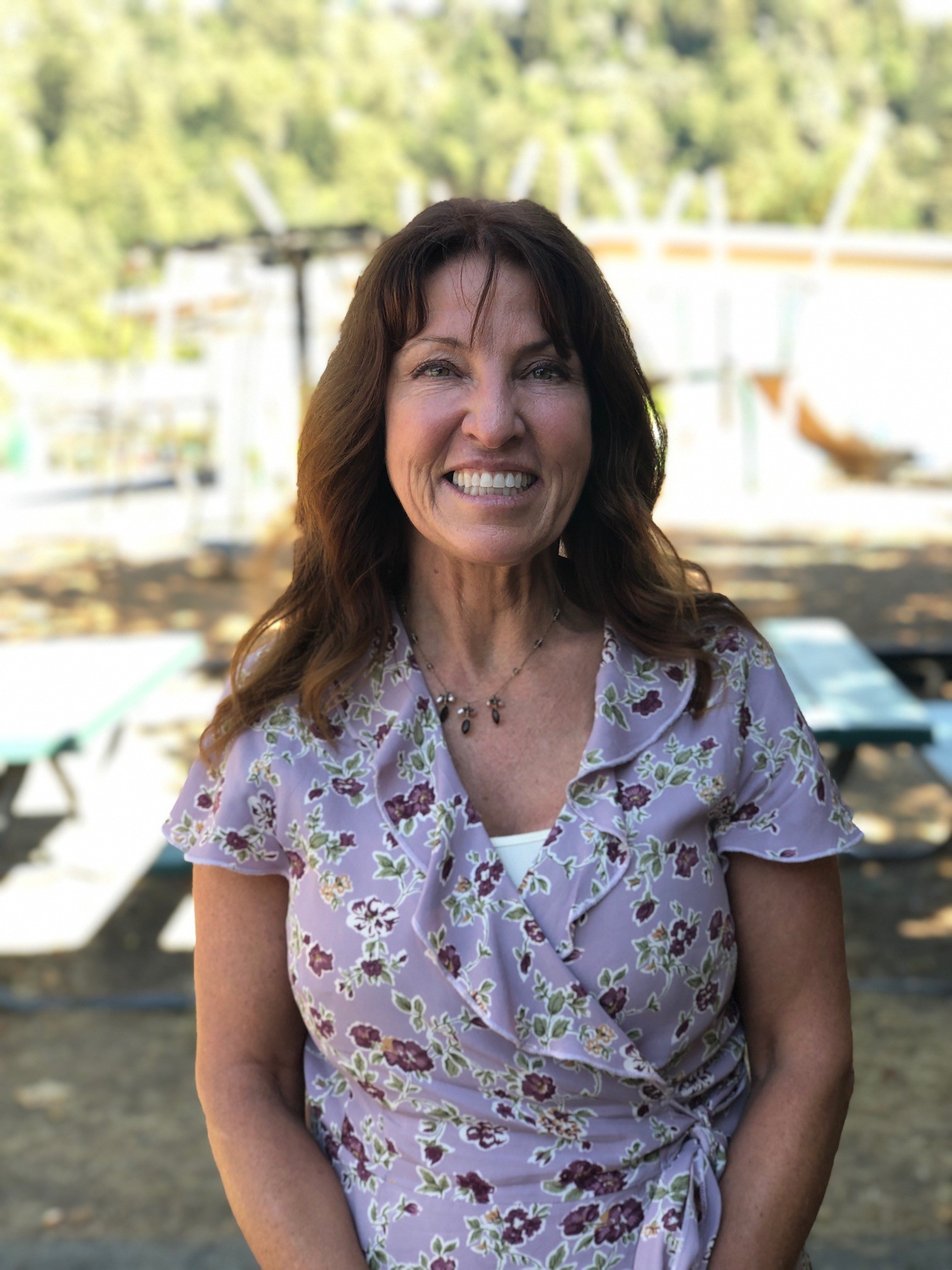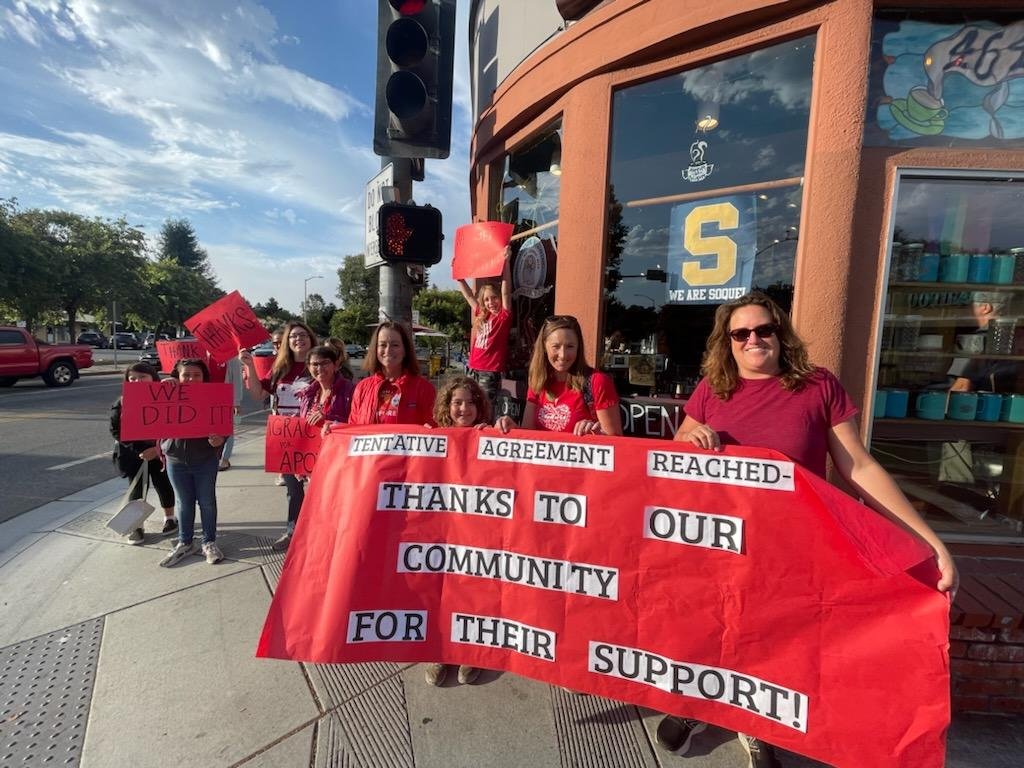
“Santa Cruz is my home. It’s empowering to make a difference for kids in this community,” says Ann Wilson, fourth-grade teacher and bargaining chair for the 110-member Soquel Education Association (SEA). “We want to stay in this community for these students. We organize for our students.”
Educators in school districts across Santa Cruz County took notice in early August when SEA educators ratified a contract that raises teacher pay in Soquel Union Elementary School District by more than 15 percent on-schedule along with a combined 7 percent in bonuses for 2021-2023. Their inspiring victory only tells part of the story though: Soquel teachers were previously the lowest paid in the county, where there is a lengthy history of woefully underpaying educators.
Compounding matters is the extremely high cost of housing in Santa Cruz, with a USA Today study in 2019 ranking the Northern California beach city and surrounding area as the least affordable place for educators in the United States. The study found that experienced Santa Cruz teachers made about $62,620 before taxes and that two-thirds of their salary went to rent. In 2021, a UC Santa Cruz report called Santa Cruz “the least affordable small city in the nation.”
“A lot of educators in this county really have a hard time making ends meet,” says Gordon Barratt, a middle school special education teacher and past president of SEA.

Gordon Barratt, Ann Wilson and D-R Martin of Soquel Education Association
These conditions are causing high turnover at schools throughout the area, as educators choose commuting through the mountains to higher-paying districts in Silicon Valley over working near home and struggling — more than 650 CTA members live in Santa Cruz County but work in neighboring Santa Clara County. In Soquel, 28 percent of teachers left the district in 2020-21 and 15 percent the year before, as the educators who stay sadly bid farewell to longtime friends and work to soften the impact to students as best they can.
“Our fight wasn’t just about being comparable in the county, it was about starting the year without teachers in the classroom,” Wilson says. “It was a crisis for our students.”
As SEA members organized, they reached out to a neighboring local association at a small, one-school district to share resources and collaborate on the low wages impacting educators. The call to Mountain Teachers Association (MTA) would turn out to be invaluable for SEA and helped spark a growing movement to improve teaching and learning conditions for all Santa Cruz County students and educators.
“Joining together is the best way we’re going to make this better for all of us,” says D-R Martin, third grade teacher and SEA president. “The power of us is real.”
Eight-member local sets the stage for change
Mountain Elementary School is nestled in the redwoods on a two-lane road that winds through the Santa Cruz Mountains. The only school in the semi-rural district, it has about 150 students, one class per grade and eight teachers — all members of MTA. Kim Dudley has taught kindergarten there for 18 years, serving for the last decade as MTA president or co-president. She says the high-performing school has long had a “culture of scarcity,” where teachers were overworked and told that small schools can’t possibly offer the pay that larger school districts do.

Kim Dudley, Mountain Teachers Association
After years of being told “there’s no money” and being misled by the former superintendent during the last bargain, Dudley dove into the district’s budget early this year, analyzing data and developing MTA’s contract proposal. With CTA staff helping to crunch the data, she says they had some “a-ha” moments that showed just how underpaid they were.
“I had to put together an air-tight case,” says Dudley, explaining that the district had a 50 percent reserve. “We needed to transform the narrative. They were saving for the rainy day, and we needed them to understand the storm was here. Unequivocally, teachers and staff were going to leave.”
What resulted was an 83-page contract proposal that told the story of what it meant to be an educator at Mountain and included data-thick sections on staffing shortages and compensation comparisons, as well as a collective resume detailing the qualifications and experience of the MTA educators.
“We wanted to say, ‘these are the people who you are going to lose’ and I was one of the people who was going to leave,” Dudley says. “Then a few weeks later, Soquel did it — and honestly, they did it better.”
In Soquel, the negotiations team worked together using MTA’s proposal as a template to create SEA’s document, which included similar number-filled charts, colorful graphs showing comparisons with other districts and a collective CV outlining their combined 1,365 years of teaching experience. Educators from the two locals had started working together during the early days of the pandemic, organizing with the seven other CTA chapters (and two California Federation of Teachers locals) in Santa Cruz County to advocate for health and safety measures. Now they were collaborating to raise educator salaries and sparking a movement across Santa Cruz.
“It felt like we were doing something extremely important and needed,” says Barratt.
Mountain educators escalated their actions slowly, and when parents joined in with them, the school board finally started to listen. MTA was able to secure better pay for their unrepresented education support professional colleagues while also winning a new salary schedule that increased the highest-paid educator salary by more than 10 percent on-schedule, as well as a 24 percent increase in the district’s health care contribution for all members. Dudley says the new contract will help keep highly qualified educators in Santa Cruz County.
“It’s been such a struggle to keep teachers here,” she says, her voice breaking. “The children suffer and that’s why we’re doing this — we’re fighting for every child.”

Emma Massie, Mountain Teachers Association
Mountain fifth-grade teacher Emma Massie says she’s hoping the new contract means she can continue to teach in her hometown.
“I grew up here and this community is important to me,” she says, adding that she’s optimistic about the years ahead. “Better teaching conditions are better learning conditions. It makes me hopeful that there is a brighter future.”
SEA members continued to organize as well, rallying at school sites and at busy intersections in Soquel, with concerned parents joining educators from CTA locals across the county attending in support, as well as the Greater Santa Cruz Federation of Teachers and Pajaro Valley Federation of Teachers. SEA provided bargaining updates to their members after every session, lifting the curtain on negotiations to be sure all members were on the same page and soliciting feedback to ensure they were responsive to member concerns.
“We were able to build confidence in our members that ‘yes, we can do this,’” Wilson says. “We’re going to keep standing up and advocating to create the schools our students deserve.”
In addition to the substantial pay raise, SEA’s victory included contractually guaranteed prep time and language reducing and protecting class sizes and caseloads. The victory was massive for educators — many members reacted to the news with tears while Martin says she knows four teachers who were planning to leave the district who have now decided to stay.
“That’s not just a win for us, that’s a win for students, administration and our community,” she says.

Educators thanked parents and the community for their support after the major victory for Soquel teachers and students.
Wilson says it’s been an emotional experience to help colleagues better meet their family’s basic needs in Soquel and beyond.
“It has this ripple effect. I think not only about our district but how it will impact others in our county and across the state, says Wilson.
According to Dudley, a cheer went up in the MTA meeting when they learned of SEA’s victory, which made her efforts all the more gratifying.
“To have any impact at all on their struggle that will allow them to stay and teach in their community, it was all worth it,” she says.
Growing movement spreads to Scotts Valley
“We felt more comfortable settling like we did because of Soquel and Mountain,” says John Magliato, middle school English and art teacher in Scotts Valley. “Hearing about their victories helped motivate us to hold strong.”
The negotiations chair for Scotts Valley Education Association (SVEA) for the past three decades, he says bargaining is always “doom and gloom” from school district administration, with worst-case scenario forecasts presented as fact only to be off by millions of dollars later. This has kept educator salaries in Scotts Valley on the low side countywide, meaning high turnover and not just among seasoned teachers.

John Magliato, Scotts Valley Education Association
“We’ve turned into a training ground for first-year teachers and (International Baccalaureate) teachers, who leave for more money. That’s the hardest part for me — losing all the teachers and having to train new ones,” Magliato says. “We need a salary schedule that’s competitive, so we stop losing teachers. It’s unclear to me why we get paid the lowest, but we live in the second-most expensive community in the country. We need to change the paradigm.”
Scotts Valley has been hit hard by teacher turnover, hiring 30 percent new staff this year alone. The issue of teacher pay and related impacts motivated SVEA members during their bargain earlier this year, with educators picketing in front of schools as often as three times a week to share their plight.
“We started to get a good deal of support from the community, who began attending school board meetings,” Magliato says. “Parents started asking a lot of questions and that led to a deal.”

Scotts Valley Education Association picketed outside school sites to raise awareness of their struggle.
Low teacher pay took center stage at a Scotts Valley School Board meeting when educators spoke to the board about how the district’s proposal to add minutes to the workday would impact their ability to arrive on time for their second jobs. One educator shared that they had been researching selling their plasma for extra money.
“The teacher shortage has a lot to do with how we’re treated,” Magliato says. “When I feel like we can do better and we don’t, it’s hard.”
After holding firm to their initial proposal and winning a 5 percent raise for 2021-2022, SVEA is headed right back to the bargaining table with the goal of improving teaching and learning conditions for all Scotts Valley students. Carried by the power their 100 members just built in the last campaign and the growing countywide effort, Magliato says he is confident in their prospects.
“We have a goal this year and are laser focused,” he says. “We felt this surge throughout the county with solidarity in union. We have a momentum here that will last a while, I think.”
Bargaining in an ecosystem
“We’re conscious of the need to make progress on issues for not only us but all teachers in Santa Cruz County,” says Nirshan Perera, English teacher at Pacific Collegiate School in Santa Cruz and president of United PCS. “There’s concerted movement to lift the boat — it’s a wonderful confirmation of the community beyond the individual associations.”
The 40 educators at the nationally acclaimed grades 7-12 charter school are currently bargaining their second contract ever, having organized United PCS and affiliated with CTA in 2019. Perera taught at the school for seven years without a union, saying that educators had an extremely limited and provisional voice during that time. Unionizing gave teachers a place and brought them together, which he says was huge when the pandemic arrived the following year.
“There’s so much the contract has brought us, and by us, I mean the school,” Perera says.

Jenny Eskenazi, Nirshan Perera and Mary Kelly Gardner of United PCS
PCS Latin and history teacher Mary Kelly Gardner says the school has also been hit by teacher turnover, with eight new educators this year. The daughter of a New York public school teacher, Gardner often thinks about how her father supported a family of five, bought a home and sent three children to college on an educator’s salary, which just isn’t possible in Santa Cruz.
“Look at the price of housing here,” says Gardner, a United PCS member. “I deserve stability and the ability to have a family and home of my own.”
During this current bargain, math educator and bargaining team member Jenny Eskenazi says members are strongly united in support, with teachers speaking out at board meetings. A Santa Cruz native, Eskenazi says educators have always been paid less there, but this new movement is changing things.
“The labor renaissance is underway. Our partnership with educators in other school districts is part of that,” says Eskenazi. “I’d drive by Soquel teachers on the corner and get emotional about it. Seeing other locals come to agreements is giving us a lot of encouragement and validation.”
Perera says that the concerted effort to bring teachers together across the county to share resources is crucial to improve conditions for all educators and students in Santa Cruz.
“It’s been a really important movement in seeing how much work is bound up in things that are bigger than us,” he says. “There’s so much gaslighting that goes on with the construct of greedy teachers. Part of what the coordination has done is highlight the larger ecosystem we work in.”
The environment, support and collaboration with fellow educators across the Santa Cruz area is energizing locals like United PCS as they head to the table.
“We have a sense of unity that is palpable,” Perera says. “We’re doing the necessary work connecting with our members, so we have a lot of strength going into the conclusion of bargaining.”
As this movement for the schools all Santa Cruz students deserve grows and organizing continues, educators are building power through their victories and gearing up for more. It’s an often-strenuous effort, but educators say it’s well worth it.
“Being a teacher is a very big job. Organizing or attending board meetings on top of that sounds like a lot of work,” says SEA’s Barratt. “When you connect it to actual change, it opens people’s eyes to why it’s so important.”
The Discussion 0 comments Post a Comment